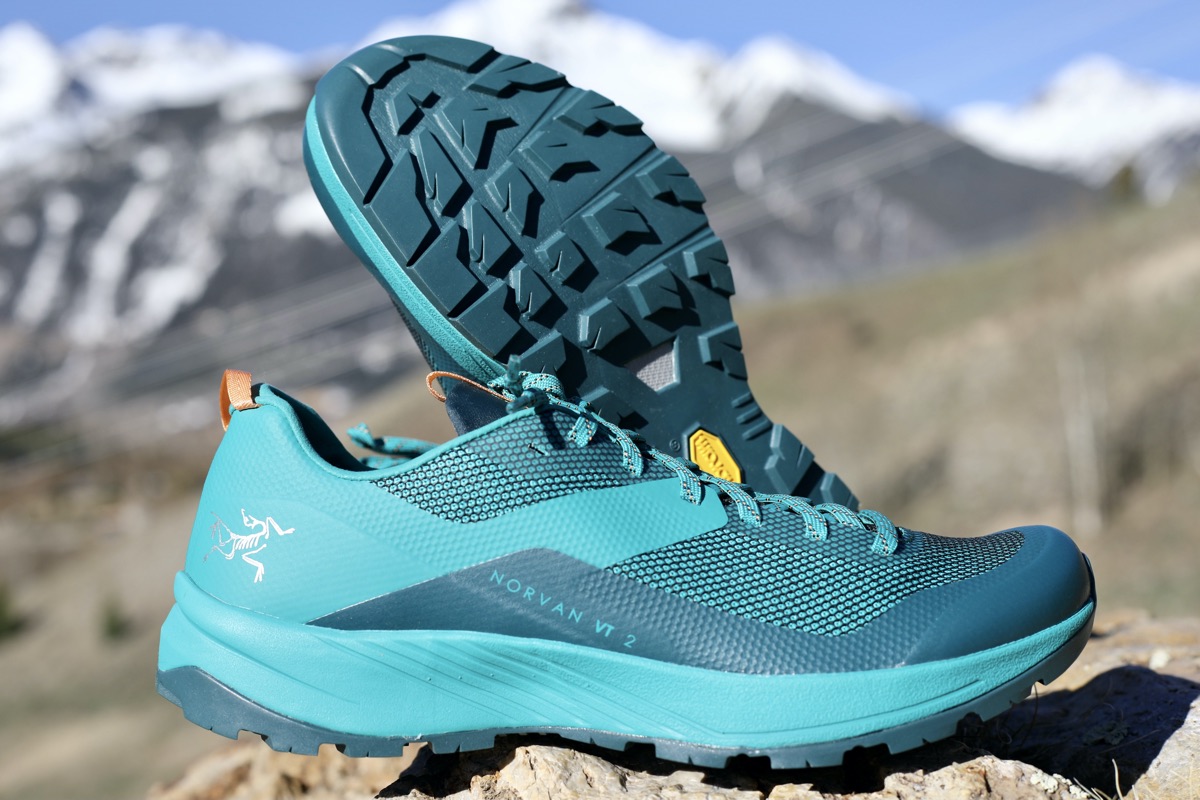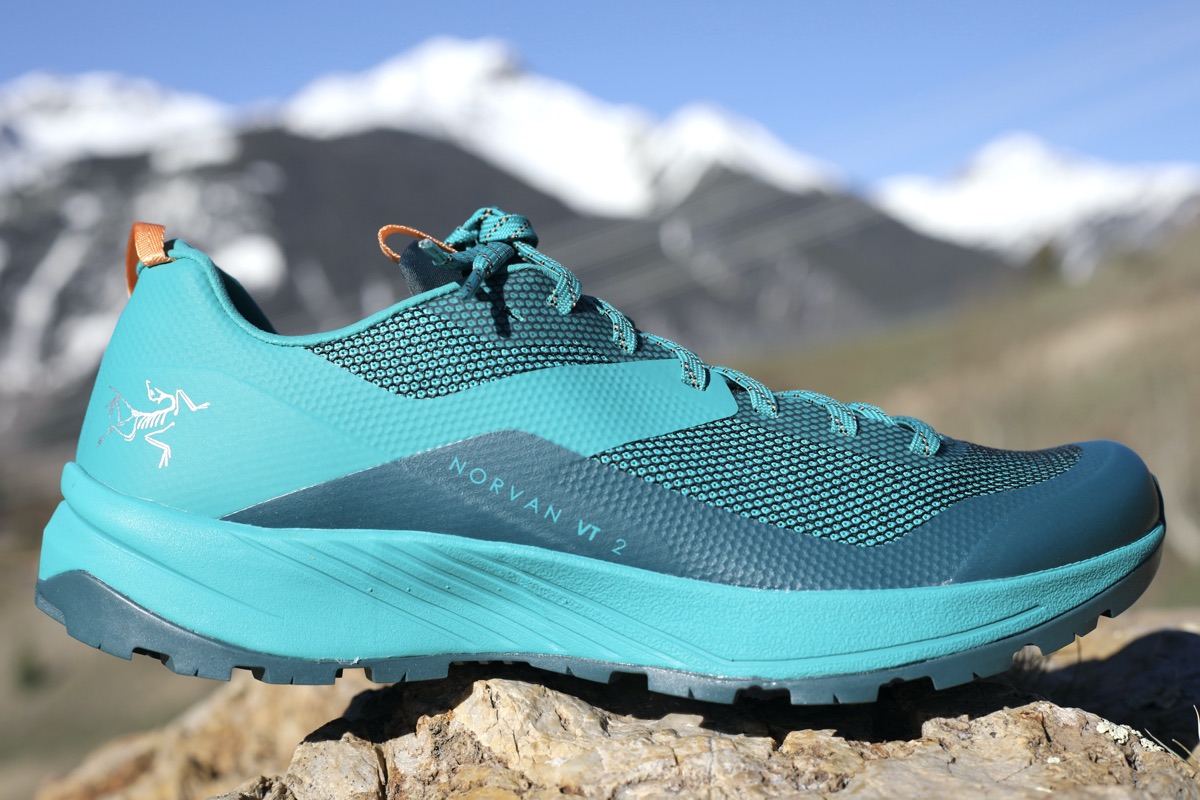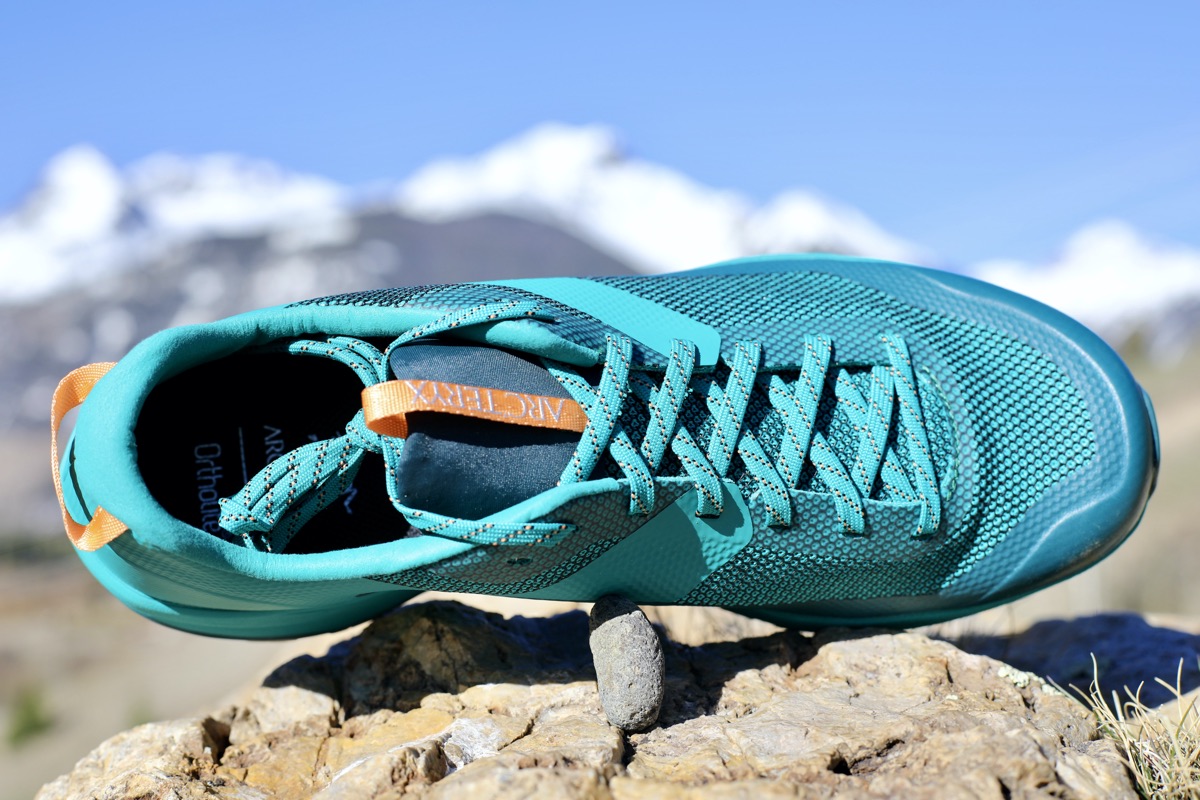Headquartered in North Vancouver, British Columbia, Canada, Arc’teryx was founded by local climbers in 1989 “to create what does not exist.” While well known for high-end, superb-quality gear in the climbing and mountaineering communities, they moved into the footwear market first in 2015 and specifically into trail running a few years later. The Arc’teryx Norvan VT 2 ($170) trail running shoes are an evolution of sorts of the original Norvan VT and they specifically target the goal of an even smoother ride during speedy trail runs with a side of scrambling thrown in. Think of this model as a trail running shoe with an approach shoe’s heart or maybe an approach shoe with a trail running soul.
I love the sticky outsole while scrambling and running in Moab, Utah, and the Arizona desert, yet find it grips really well on wet dirt mixed with rocks and slabs on shorter runs in Colorado. While not the lightest, widest, or most cushioned of trail running shoes—Arc’teryx offers other shoes for that in the Norvan SL 2 and Norvan LD 2 models—when you need exceptional grip and agility on talus, technical trail, and up to mid-distance trail running, the Norvan VT 2 is an excellent option. The shoes weigh in at 11.3 ounces (320 grams) in a men’s size 9 and 10.1 ounces (285 grams) in a women’s size 7.
One note on sizing, I wear the same size in Arc’teryx and Salomon trail running shoes, which are one full size smaller than my La Sportiva or New Balance shoes and a half-size smaller than shoes by Columbia Montrail, Merrell, and The North Face.
Shop the Women's Arc’teryx Norvan VT 2Shop the Men's Arc’teryx Norvan VT 2
Arc’teryx Norvan VT 2 Upper
The upper of the Arc’teryx Norvan VT 2 is a relatively breathable single-layer mesh that dries fairly quickly and keeps desert sand and other debris out. It’s breathable enough that feet can feel rather chilly during winter runs— running sock choice is important here. But Arc’teryx also offers the Norvan VT 2 GTX as a more weather-resistant option. This breathability pays off in summer temperatures when the breeze helps to cool the feet. Thermoplastic polyurethane (TPU) overlays provide absolutely excellent protection for minimal increase in weight around the entire toecap, sides of the shoe, and heel cup, giving the appearance of extending the substantial yet flexible rand. Increased density of the TPU along the medial side protects the arch and the midfoot from sharp edges of rocks and provides a bit more structure for edging and scrambling moves. Though the overlays do decrease some of the breathability and drying ability, the number of times they’ve saved my feet from cactus thorns and nasty rock angles has made it all worth it.
The toebox is on the narrower side of average, but not so snug that “soccer boot” or “climbing shoes” come to mind. Those with wider feet may find it a bit lacking, however. The shoes are amply sized for my foot shape, but I did find if I spent more than two to three hours mashing around on awkward angles during my run, the medial side of my great toe would begin to have a hot spot—a bit more width would solve this quickly.
The lace eyelets are actually vertical slits and reinforced by the TPU overlays rather than with metal/plastic holes, which work well and keep the laces from rotating within their eyelet. The laces are flat and relatively standard but stay secure with a simple double knot and create a snug midfoot wrap and fit. A stretchy, well-sized lace garage lies on top of the relatively thin yet comfortable gusseted tongue, though I didn’t find I needed it or remembered to used it. Not once have my laces caught on a root or branch. Handy pull loops are attached to the tongue and upper heel cup area which make getting the shoes on quite easy. Slipping out of them without undoing the laces is a bit more difficult due to the secure fit provided.
The heel cup is slim, structured, and relatively stiff, which adds security with technical terrain but is minimally padded, which meant for some sore ankle bones because of the ankle collar’s edges when I initially began wearing the shoe. I didn’t have any issues with blisters, which was likely helped with the very smooth, suede-like interior fabric. Considerable flexibility in the top border of the Achilles tendon area offsets the relatively straight cut here, which keeps it comfortable.
This brings up an interesting point. I’m pretty used to my trail shoes requiring no break-in period and being perfectly comfortable out of the box. I found the Norvan VT 2 to be somewhat uncomfortable and clunky feeling for the first 30 to 40 miles due to overall stiffness of the upper and sole and the firm midsole cushioning. Once the shoe softened up a bit after that period, the upper felt more accommodating and the shoe had a smoother roll from heel to toe. At that point, the Norvan VT 2 really began to shine.
One other thing to note with the upper, some users have reported significant abrasion wear and even failure of the upper’s mesh after a month and less than 150 miles of wear, particularly along the medial aspect at the junction of the TPU overlay. I did not have issues with this and have found the shoes to be very durable and resistant to wear, but I suspect my less aggressive style on technical terrain may have something to do with that. It appears Arc’teryx is very aware of this and is responding to each user who reports it.
Arc’teryx Norvan VT 2 Midsole
The midsole of the Arc’teryx Norvan VT 2 feels quite firm underfoot and is constructed from a durable Ethylene-Vinyl Acetate/Polyolefin (85%/15%) blend. The firmness limits the distance I can wear the shoe to sub-ultramarathon distances with the sweet spot being something between six and 15 miles. What it lacks in perceived cushion, it more than makes up for in technical-terrain prowess, so for me, it’s a fair tradeoff. This is where that approach-shoe vibe is noted. A bit of additional cushioning and support comes from the 4mm thick OrthoLite 3D molded, removable insert, which I always love as it keeps my feet happy. I know some people don’t prefer this insert due to water retention, but I don’t seem to have an issue with that. More of my miles also tend to be run in a relatively dry environment, so water retention isn’t often a thing I deal with. The 8mm drop is my favorite for comfort and a happy biomechanical posterior chain, but with the 25mm/17mm heel-toe stack height I still feel connected to the trail after the overall stiffness during the break-in period subsided. While I loved this shoe for climbing on rocky terrain, and it has adequate performance on smooth dirt singletrack, I really would prefer more cushioning and responsiveness for the downhills to eliminate some of the “pounded feet” discomfort by the end of 15 miles of rocks and hard-packed dirt.
Arc’teryx Norvan VT 2 Outsole
Vibram MegaGrip rubber compound gives the Arc’teryx Norvan VT 2’s outsole excellent durability and grip on wet and dry rocks, slabs, roots, and about any other technical aspects you throw at the shoe. With only 4mm deep multidirectional lugs, it’s not exactly a snow or muck shoe, but for what the shoe is designed for, it’s perfect. If the lugs were too deep, it wouldn’t provide the same confidence on rocks. With almost 200 miles in the shoe, my outsole is still looking minimally scuffed and the stickiness still excels as proven once again on some desert slickrock adventures just this past week even with some moisture due to spring storms. I really appreciate the confidence this outsole gives me on rocks in particular, even if some sand, thin wet snow, and rubble spice it up. Again, it seems there’s some inherent stiffness that is absolutely necessary for the targeted use, but it did need to soften a bit to decrease the foot slap that was common in the early days of wearing the shoe.
Arc’teryx Norvan VT 2 Overall Impressions
Arc’teryx has a really interesting offering in the Arc’teryx Norvan VT 2 for those seeking a shoe that performs very well on short-to-medium-distance technical trail runs with scrambling and approach-style climbing included as well. I could see it being ideal as an actual approach shoe for those who prefer a bit more trail running agility from their footwear. At $170, the price is steep for those of us who would then need a second shoe to get the cushioning that would allow for ultra distances and really long days in the mountains. The durability of the outsole and midsole are outstanding, and my own personal experience suggests the upper is very durable as well. I hope Arc’teryx can address some of the issues that have arisen for others along that medial aspect of the upper, so runners can be as aggressive with their style as desired without worry of a shoe failure.
Shop the Women's Arc’teryx Norvan VT 2Shop the Men's Arc’teryx Norvan VT 2
Other Versions of the Arc’teryx Norvan VT 2
You might be interested in the waterproof edition of this shoe: the Arc’teryx Norvan VT 2 GTX men’s version and Arc’teryx Norvan VT 2 GTX women’s version.
Call for Comments
- Are you running in the Arc’teryx Norvan VT 2? What do you think?
- Is the midsole a relatively firm ride for you?
- How does the outsole perform?
[Editor’s Note: If you’re affiliated (i.e., an employee, ambassador, etc.) with a brand, please share your relation in each of your comments on this article. Thanks!]
Our Favorite Trail Running Shoes
Check out our Best Trail Running Shoes article to learn about our current favorite trail running shoes!





